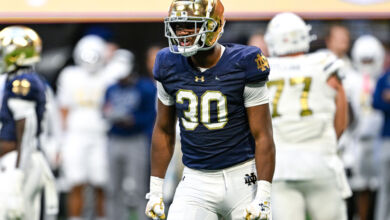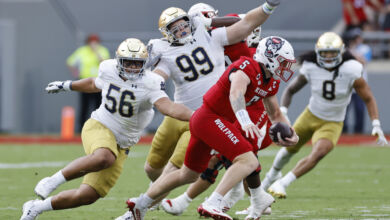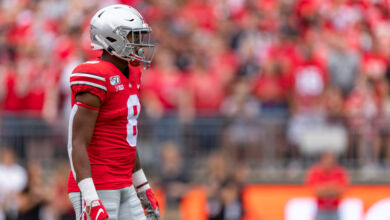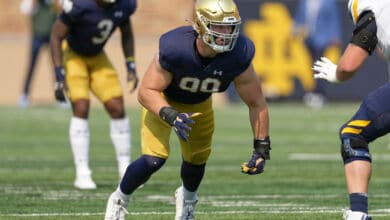- DIGGING DEEPER
Through the first four games played in 2007, Notre Dame had allowed 24 sacks. In 2008, the Irish have allowed just four sacks. With three returning starters and essentially two red-shirt juniors, the Irish offensive line has gone from allowing six sacks per game to one through four contents. It should also be noted the Irish allowed none in the first two games, three in the third, and one in the fourth.
However, with every silver lining, there will always be somebody who is able to research stats that might give some pause to concern. Before we hit those stats, let’s be clear. Allowing one sack per game so far this season, after giving up an NCAA record 58 a year ago, is something every fan should be ecstatic about. The offensive line and coaching staff should be commended for this improvement.
However, one issue of concern I have noticed is the larger than normal down and distance the Irish face after taking a sack. A later scan of the NCAA statistics would confirm my suspicion. Notre Dame is in the lower sixth of the country in sacks allowed, a very positive place to be. But the Irish are fourth worst in the nation at yards lost per sack. Of note, Texas Tech is third worst, but they have only given up one sack.
- THE SACK NUMBERS
| TEAM | ATT | SACKS | YARDS | YPS |
| Bowling Green | 159 | 8 | 91 | 11.4 |
| Marshall | 158 | 3 | 33 | 11.0 |
| Texas Tech | 202 | 1 | 11 | 11.0 |
| Notre Dame | 131 | 4 | 42 | 10.5 |
| Tennessee State | 149 | 7 | 68 | 9.7 |
| Oklahoma State | 79 | 2 | 19 | 9.5 |
| Miami (OH) | 155 | 7 | 66 | 9.4 |
| Nevada | 121 | 9 | 81 | 9.0 |
| Kentucky | 136 | 2 | 18 | 9.0 |
| Michigan State | 131 | 1 | 9 | 9.0 |
| All other NCAA teams have < 9.0 yards lost per sack | ||||
So far this season in the NCAA FBS, a sum of all teams has given up 841 sacks for 5600 yards lost, averaging out to a loss of 6.7 yards per sack. This means the Irish are giving up almost four yards more per sack than the national average.
- QUARTERBACK DRILLS
As somebody who played quarterback at one of the nation’s best high school programs, we had the luxury of outstanding coaching and our coaches had excellent personal resources. Though the majority of my playing time came as a third wide receiver, I was our team’s backup quarterback and had significant practice time dedicated towards the quarterback position.
Our offensive coordinator and quarterbacks coach at Mater Dei High School (Santa Ana, CA) was Dave Money, who is still at the school today. Coach Money has groomed Matt Leinart, Colt Brennan, Matt Barkley and many others.
In addition to learning from Coach Money, during the off-season, our starting quarterback would bring his receivers to personal work out sessions with Southern California based quarterback guru, Steve Clarkson. Some of the many names Clarkson has mentored include Roethlisberger, Leinart, Losman, Torretta, Clausen and Barkley (this year’s #1 high school quarterback recruit, committed to USC). Yes, Steve Clarkson was Jimmy Clausen’s personal quarterback coach.
One of the drills Coach Money and Steve Clarkson puts their quarterbacks through are called “Elway’s,” named after NFL Hall of Famer John Elway. In this drill, the quarterback is standing in the pocket with the football (against air or against semi-static defenders) and is looking down field. He is concurrently chopping his feet while taking instructions from the coach to shuffle in the direction of where the coach points. The quarterback will shuffle up and back in the pocket, and laterally to the left and right.
These agility drills were designed to achieve elite footwork when moving throughout the pocket. At the conclusion of each round, the coach would crank his right or left arm as if he is spinning a hand wheel, and then the quarterback would spin in pirouette fashion and then roll to that side where he would attempt a pass to one of the student managers.
Two examples of this spin and bail rollout can be seen at the 1:08 through 1:16 mark in this video. Note, the video does include the important aspects of lateral footwork inside the pocket, which is the primary focus of the “Elway” drills. (Feel free to mute the volume)
[youtube]KHRxuZOcrmk[/youtube]- WHAT DOES THIS MEAN?
Nobody would ever accuse Jimmy Clausen has being fleet of foot. But Clausen has been able to avoid numerous sacks so far this season by using many of the techniques including the ones mentioned above. Often, the Clarkson/Money model has quarterbacks escaping the collapsing pocket by arching. Sometimes quarterbacks choose only to step up and find any light forward in a collapsing pocket while others run parallel to the line of scrimmage and choose not to lose any further yards. The catch-22 for the Notre Dame offense is Clausen’s history of quarterback education, and the spin to rollout. When Clausen attempts this move, he immediately loses several yards from his initial pocket drop. As I mentioned before, Clausen has done an excellent job avoiding about twice as many sacks as the Irish have given up. But attempting to escape, going backwards and getting pulled down will lead to more lost yardage than just standing in the pocket and taking your losses.
So far, so good this year as the Clausen has only been sacked four times compared to the 24 from last year. But when he is sacked, because the yardage lost is the fourth worst in the NCAA, this is nearly an instant drive killer. You are fundamentally asking an offense to obtain four more yards than the NCAA average after a sack. Clausen’s lone sack in the Purdue was the result of an excellent move by the defender, who overpowered Irish left guard Eric Olsen. The move enabled the defender to meet Clausen almost at the same instant as he set his feet in the pocket and sacked him for an eight yard loss and set up 2nd and 18. The very next play, Clausen delivered an 18-yard pass to Kyle Rudolph for a first down. Had Clausen lost the Irish season average on the sack, instead of 1st and 10, the Irish would have faced a 3rd and 3.
The Irish are 18 of 51 (35%) for the season on third down conversions. With an already meager conversion rate, any sack resulting in lost yardage will likely result in the drive going dead. The one time this season the Irish continued a drive after a sack was the example above against Purdue. However, against Michigan State, Clausen was sacked three times and all three resulted in punts. Two of the three sacks in the Michigan State game, Clausen attempted to bail out of the pocket using the techniques mentioned in this article.
- CONCLUSION
The “Elway” drill as a factor to do with lost sack yardage is simply a hypothesis by yours truly. I do not have the privileged knowledge of the techniques Charlie Weis, Michael Haywood and Ron Powlus teach their quarterbacks. I do know I have repeatedly seen Jimmy Clausen attempt the techniques as taught by a common instructor we shared. In two of the four sacks this year, he attempted to use that technique and those sacks resulted in losses of 10 and 16 yards respectively. Other factors may contribute to excessive lost yardage in sacks compared to the rest of the nation. For instance, starting a play in the shotgun and then continuing to drop back once Clausen has received the snap may be a contributing factor. Also, play-action or a five-step (usually 6-8 yards) or seven-step (usually 8-10 yards) drop on any type of long developing play may also have an impact on disproportionate lost yardage. Consider last season when Notre Dame gave up the record 58 sacks. Demetrius Jones was sacked once in the Georgia Tech game, and Clausen split time with Even Sharpley most of the year. But the Irish only gave up 7.2 yards lost per sack. This could be a product of a short passing game or the fact that Clausen and Sharpley were mostly deer in the headlights and often just stayed flat footed in the pocket because they were so overwhelmed by the game going on around them.
Notre Dame and Jimmy Clausen are currently operating in high-risk, high-reward mode when it comes to pass protection. Clausen’s increased pocket presence and ability to avoid numerous sacks thus far, have made for tremendous positive strides from a year ago. But if he hesitates a count too long on his decision to flee, he is simply not quick enough to shake a defender who is not engaged by offensive blockers and is closing in on the Irish quarterback.
For football fans who enjoy the X’s & O’s and the fundamentals of the game, keep an eye out in the games for the points raised in this article. Watch Jimmy Clausen’s footwork in the pocket. How does he scramble successfully? How did he attempt to escape when he was sacked? If he had an opportunity to scramble, did he step up in the pocket, try to run lateral or parallel to the line of scrimmage, or did he try to arch around and bail as described by the “Elway” drills?
If you notice something in past games or in the future, feel free to post a comment on the blog or head over to the UHND Football Message Board and open up a new topic to discuss the incredibly complex strategies in the game of football.



